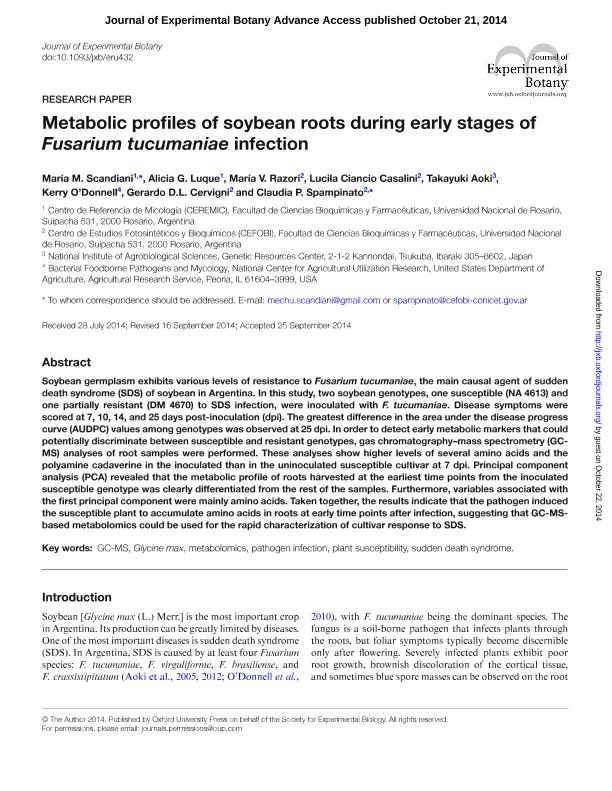Artículo
Metabolic profiles of soybean roots during early stages of Fusarium tucumaniae infection
Scandiani, María M.; Luque, Alicia G.; Razori, María V.; Ciancio Casalini, Lucila; Aoki, Takayuki; O´Donnell, Kerry; Cervigni, Gerardo Domingo Lucio ; Spampinato, Claudia Patricia
; Spampinato, Claudia Patricia
 ; Spampinato, Claudia Patricia
; Spampinato, Claudia Patricia
Fecha de publicación:
01/2015
Editorial:
Oxford University Press
Revista:
Journal Of Experimental Botany
ISSN:
0022-0957
Idioma:
Inglés
Tipo de recurso:
Artículo publicado
Clasificación temática:
Resumen
Soybean germplasm exhibits various levels of resistance to Fusarium tucumaniae, the main causal agent of sudden death syndrome (SDS) of soybean in Argentina. In this study, two soybean genotypes, one susceptible (NA 4613) and one partially resistant (DM 4670) to SDS infection, were inoculated with F. tucumaniae. Disease symptoms were scored at 7, 10, 14, and 25 days post-inoculation (dpi). The greatest difference in the area under the disease progress curve (AUDPC) values among genotypes was observed at 25 dpi. In order to detect early metabolic markers that could potentially discriminate between susceptible and resistant genotypes, gas chromatography–mass spectrometry (GC-MS) analyses of root samples were performed. These analyses show higher levels of several amino acids and the polyamine cadaverine in the inoculated than in the uninoculated susceptible cultivar at 7 dpi. Principal component analysis (PCA) revealed that the metabolic profile of roots harvested at the earliest time points from the inoculated susceptible genotype was clearly differentiated from the rest of the samples. Furthermore, variables associated with the first principal component were mainly amino acids. Taken together, the results indicate that the pathogen induced the susceptible plant to accumulate amino acids in roots at early time points after infection, suggesting that GC-MS-based metabolomics could be used for the rapid characterization of cultivar response to SDS.
Archivos asociados
Licencia
Identificadores
Colecciones
Articulos(CEFOBI)
Articulos de CENTRO DE EST.FOTOSINTETICOS Y BIOQUIMICOS (I)
Articulos de CENTRO DE EST.FOTOSINTETICOS Y BIOQUIMICOS (I)
Citación
Scandiani, María M.; Luque, Alicia G.; Razori, María V.; Ciancio Casalini, Lucila; Aoki, Takayuki; et al.; Metabolic profiles of soybean roots during early stages of Fusarium tucumaniae infection; Oxford University Press; Journal Of Experimental Botany; 66; 1; 1-2015; 391-402
Compartir
Altmétricas



